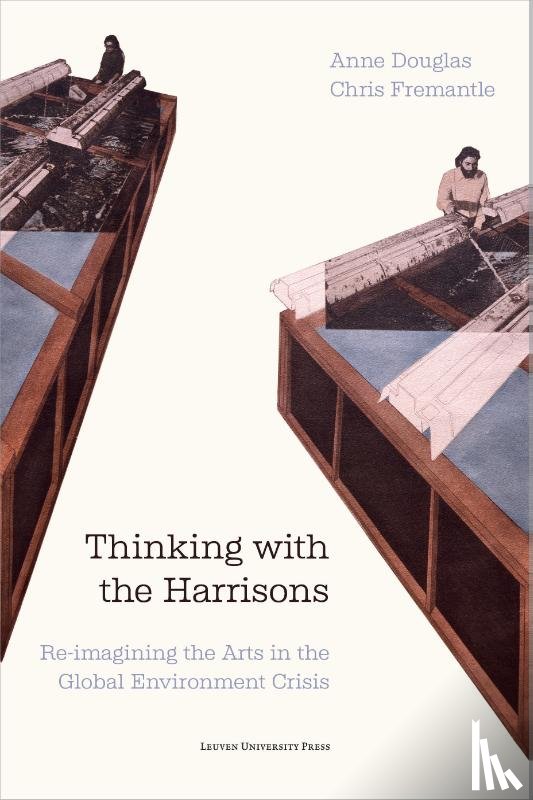Omschrijving
What is the role of the arts in the global environmental crisis? Helen Mayer Harrison and Newton Harrison, known as ‘the Harrisons’, dedicated five decades to exploring and demonstrating a new approach to artistic practice, centred on “doing no work that does not attend to the wellbeing of the web of life.” Their collaborative practice pioneered a way of drawing together art and ecology. They closely observed, often with irony and humour, how human intervention disrupts the dynamics of life as a web of interrelationships. The authors of this book ‘think with’ the Harrisons, critically tracing their poetics as a reimaging and reconfiguring of the arts in response to the unfolding planetary crisis. They draw parallels between the artists’ poetics and rethinking in the philosophy of science, particularly drawing on the work of Isabelle Stengers and Alfred North Whitehead.Thinking with the Harrisons is for anyone concerned with the implications of ecology as part of a reimagining of public life, including through the interaction of art and science. Throughout their joint practice, the Harrisons sought to engage policy makers, governments, ecologists, artists, and inhabitants of specific places, sensitizing us to the crises that emerge from grounded experiences of place and time.Anne Douglas is a Professor Emerita, Gray’s School of Art, Robert Gordon University, Scotland, who explores the changing place of the artist in public life. Her research has increasingly focused on art and the environmental crisis from a practice-led perspective. She co-produced the Harrisons’ work On the Deep Wealth of this Nation: Scotland (2017) in collaboration with Newton Harrison and the Centre for the Study of the Force Majeure, University of California Santa Cruz.Chris Fremantle is a researcher and producer of award-winning projects, including the Harrisons’ project Greenhouse Britain: Losing Ground, Gaining Wisdom. He is a longstanding member of the international ecoart network and co-editor of ‘Ecoart in Action’, a collection of activities, case studies and provocations drawn from the network. He lectures at Gray’s School of Art, Robert Gordon University, Scotland. Helen Mayer Harrison and Newton Harrison, known as ‘the Harrisons’, dedicated five decades to exploring and demonstrating a new approach to artistic practice, centred on “doing no work that does not attend to the wellbeing of the web of life.” Their collaborative practice pioneered a way of drawing together art and ecology. They closely observed, often with irony and humour, how human intervention disrupts the dynamics of life as a web of interrelationships. The authors of this book ‘think with’ the Harrisons, critically tracing their poetics as a reimaging and reconfiguring of the arts in response to the unfolding planetary crisis. They draw parallels between the artists’ poetics and rethinking in the philosophy of science, particularly drawing on the work of Isabelle Stengers.
Thinking with the Harrisons is for anyone concerned with the implications of ecological concerns as a reimagining of public life, including the interaction of art and science. Throughout their joint practice, the Harrisons sought to engage policy makers, governments, ecologists, artists, and inhabitants of specific places, sensitizing us to the crises that emerge from grounded experiences of place and time. ACKNOWLEDGEMENTS 9
CHAPTER 1: INTRODUCTION: SEEKING A DIFFERENT PLACE FOR THE ARTS IN SURVIVAL 11
CHAPTER 2: ‘THINKING WITH’ WHITEHEAD, STENGERS AND THE HARRISONS 29
The Bifurcation of Nature 30
Nature as emergent 32
Adventure and/as a ‘leap of the imagination’ 33
What is ‘adventure’ in the Harrisons’ works? 39
Inhabiting the bifurcation of nature 39
CHAPTER 3: THE LAGOON CYCLE 49
The Poem as Visual Essay 52
Bifurcation of Nature: Collisions between East and West 65
Bifurcation of Nature: Exploitation 69
The Leap of the Imagination 72
Inventing a field 75
Adventure 75
Storytelling 80
In what sense is The Lagoon Cycle an event? 83
Conclusions 84
CHAPTER 4: ON IMPROVISATION 87
What is improvisation? 89
An instrument in skilled hands 90
A fine line between communicability and adventure, between certitude and risk 94
A predicament, not something freely chosen … 96
Creating a ‘more to life’ 97
Generative metaphor 104
What does improvisation make matter? 105
CHAPTER 5: ON THE POETICS AND AESTHETICS OF SYSTEMS 109
Systems: A way of thinking 112
Artists and systems – Haacke and Ukeles 116
Burnham’s Proposed ‘Systems Aesthetics’ 125
The Harrisons’ use of ‘systems’ 128
Spoils Pile Reclamation 130
Reclamation for whose benefit? 135
Metaphor as organiser 136
CHAPTER 6: ON THE POLITICAL 141
Re-finding humanity: Arendt’s context for writing on the political 146
Kant’s construction of the political in aesthetics 151
What does it mean to develop politics based in judgement? 153
The Harrisons and their publics 156
The Art of Narrative resides in the Ability to condense the Action into an Exemplary
Moment (Kristeva 2020, 17) 158
The Spectator is not Involved in the Act (Arendt 1992, 63) 161
Mortality, Communicability, Freedom 162
How does the political as outlined here work with codes of conduct and constitutional
forms? 165
Otherwise the race of devils would destroy themselves (Arendt 1992, 18) 171
What to do? 173
CHAPTER 7: ARTISTS ‘THINKING WITH’ ONE ANOTHER 177
On questions that drive practice 178
Pedagogy: Curriculum Proposals 184
Ballengée, Bon, Goto-Collins and Collins, Sprinkle and Stephens, Wallen 188
A Wider Reimagining of the Role of the Arts 208
CONCLUSIONS 213
NOTES 217
TIMELINE 223
REFERENCES 229
INDEX 239


